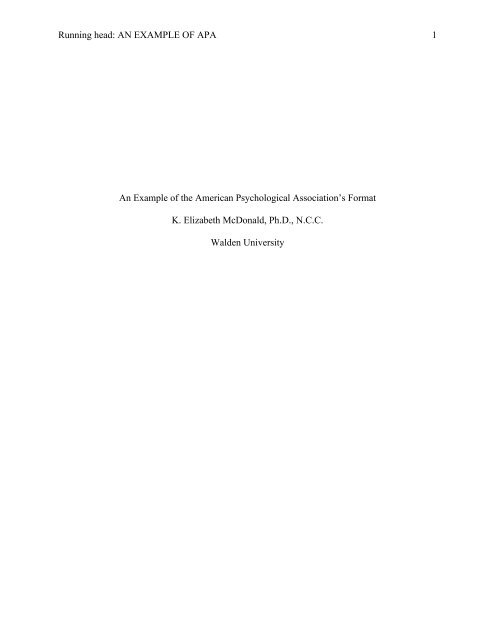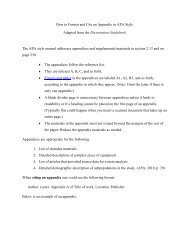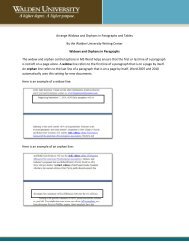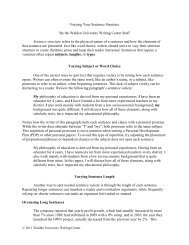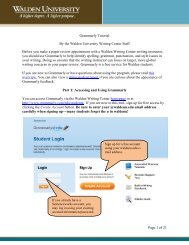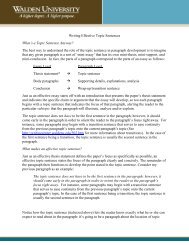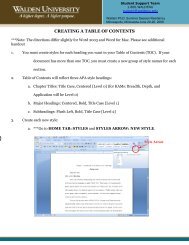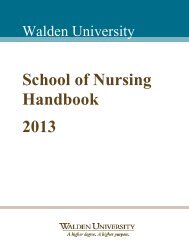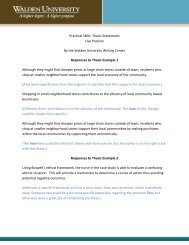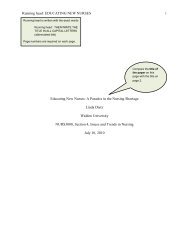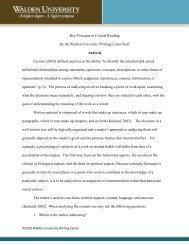Running head: AN EXAMPLE OF APA 1 An ... - Writing Center
Running head: AN EXAMPLE OF APA 1 An ... - Writing Center
Running head: AN EXAMPLE OF APA 1 An ... - Writing Center
You also want an ePaper? Increase the reach of your titles
YUMPU automatically turns print PDFs into web optimized ePapers that Google loves.
<strong>Running</strong> <strong>head</strong>: <strong>AN</strong> <strong>EXAMPLE</strong> <strong>OF</strong> <strong>APA</strong> 1<strong>An</strong> Example of the American Psychological Association’s FormatK. Elizabeth McDonald, Ph.D., N.C.C.Walden University
<strong>AN</strong> <strong>EXAMPLE</strong> <strong>OF</strong> <strong>APA</strong> 5readers as to the purpose/point of the document. Consider adding more <strong>head</strong>ings if you only haveone level of <strong>head</strong>ing.It is likely that you will be using three levels of <strong>head</strong>ing for most papers in classes. Thisdocument uses four levels of <strong>head</strong>ing. Most literature reviews should be either three or fourlevels. The format of each level is illustrated below:<strong>Center</strong>ed, Boldface, Uppercase and Lowercase HeadingLeft-Aligned, Boldface, Uppercase and Lowercase HeadingIndented, boldface, lowercase <strong>head</strong>ing with a period.Indented, boldface, italicized, lowercase <strong>head</strong>ing with a period.Indented, italicized, lowercase <strong>head</strong>ing with a period.Citations and ReferencesCitations are credit given to authors in the text. When an author fails to cite others for hisor her ideas, the author plagiarizes. References are included at the end of the document, andinclude all information needed for the reader to locate the original document (e.g., book, journal,website). The next section covers how to cite in text, followed by how to format the referencepage.Citations in TextDocument your manuscript by citing the author and date of the works utilized to composeyour document. This allows the reader to quickly identify sources and locate the entire source atthe end of the manuscript (in the references). In order to cite a source, you must first determine ifthere is/are (a) one author, (b) two authors, (c) three to five authors, or (d) six or more authors.<strong>An</strong> example of how to cite each of these appears here, both when the author’s name appears aspart of the narrative, and when it does not. Please note that “within a paragraph, when the name
<strong>AN</strong> <strong>EXAMPLE</strong> <strong>OF</strong> <strong>APA</strong> 6of the author is part of the narrative…you need not include the year in subsequentnonparenthetical references….Do include the year in all parenthetical citations” (<strong>APA</strong>, 2010, p.174). See the <strong>APA</strong> manual for more information.One author citation. McDonald (2009) indicated that red, blue, and yellow latex heliumballoons make her happy. Elizabeth is made happy by red, blue, and yellow latex heliumballoons (McDonald, 2009). McDonald discovered that, within a paragraph, you need notinclude the year of an already cited source in subsequent citations, so long as it is in the narrativeand not in a parenthetical. Citing one author is rather straightforward (McDonald, 2009).Two author citation. McDonald and Merk (2009) are not night owls. Night owls gowhoooo in the night (McDonald & Merk, 2009). Always cite both names every time thereference occurs in the text (McDonald & Merk, 2009). McDonald and Merk, however,discovered that the year need not be included in subsequent in-text citations as long as it is not ina parenthetical. Note that when citing multiple authors in the narrative, the word and is used, butwhen the names are in a parenthetical, an & is used (McDonald & Merk, 2009).Three to five author citation. Hutchison, McDonald, Reed, and Datti (2006) are crazypeople who like <strong>APA</strong>. It has been found that <strong>APA</strong> format makes most people very angry(Hutchison et al., 2006). Cite all authors the first time the reference occurs. In subsequentcitations, include only the surname of the first author followed by et al. and the year in the firstcitation of the reference within a paragraph (Hutchison et al., 2006). Hutchison et al. found thisvery confusing, despite their masochistic passion for <strong>APA</strong>.Six or more author citation. McDonald et al. (1979) are nutso. It is actually kind of nicewhen there are six or more authors, because you only cite the surname followed by et al.(McDonald et al., 1979). Cite only the surname of the first author followed by et al. (with a
<strong>AN</strong> <strong>EXAMPLE</strong> <strong>OF</strong> <strong>APA</strong> 8Note only the periodical title and volume number are in italics. In the title, capitalize only thefirst letter of the title of article (and first letter of sub<strong>head</strong>ing if applicable). For example, in thearticle “Night Owls Who Love Cheese,” there is no period at the end of the reference in thereferences list. Include the article’s DOI (provide the URL for the journal homepage if no DOI isavailable). The retrieval date and database information are not needed for scholarly articlesretrieved from online sources. The website should not have a hyperlink.Author, A. A., Author, B. B., & Author, C. C. (2009). Title of article: Sub<strong>head</strong>ing if applicable.Title of Periodical in Italics, xx, xxx-xxx. doi:10.4179/0423198108282008Nonperiodical. A nonperiodical is printed once, such as a book. After this paragraphthere will be an example of how to reference a nonperiodical. Note only the Title of work isitalicized. Capitalize only the first letter of the title of the article source (and first letter ofsub<strong>head</strong>ing if applicable). Place a period at end of the reference.Author, A. A. (2009). Title of work: Sub<strong>head</strong>ing if applicable. Goshen, IN: Publisher.Part of a nonperiodical. <strong>An</strong> example of a part of a nonperiodical is a book chapter. Afterthis paragraph, there will be an example of how to reference part of a nonperiodical. Note onlythe title of work is italicized. Capitalize only the first letter of the title of the article or chapter(and first letter of sub<strong>head</strong>ing if applicable). Place a period at the end of the reference.Author, A. A. (2009). Title of chapter: Sub<strong>head</strong>ing if applicable. In A. Editor, B. Editor, & C.Editor (Eds.) Title of work (pp. xxx-xxx). Location: Publisher.Online document. After this paragraph there will be an example of how to reference anonline document. Capitalize only the first letter of the title of article (and first letter ofsub<strong>head</strong>ing if applicable). There is no period at the end of the reference. The website should nothave a hyperlink.
<strong>AN</strong> <strong>EXAMPLE</strong> <strong>OF</strong> <strong>APA</strong> 9Author, A. A., Author, B. B., & Author, C. C. (2009). Title of article: Sub<strong>head</strong>ing if applicable.Retrieved month day, year, from http://www.source.comOnline multipage document created by a private organization. After this paragraphthere will be an example of how to reference an online multipage document. If the date is given,simply omit n.d. (which stands for no date) and insert the date. Note only the title of the webpageis in italics. Capitalize only the first letter of the title of article (and first letter of sub<strong>head</strong>ing ifapplicable). There is no period at the end of the reference. The website should not have ahyperlink.Name of Organization. (n.d.). Title of webpage: Sub<strong>head</strong>ing if applicable. Retrieved month day,year, from http://www.source.orgStand-alone online document, no author. After this paragraph there will be an exampleof how to reference a stand-alone online document. If the date is given, simply omit n.d. (whichstands for no date) and insert the date. Note only the title of the webpage is in italics. Capitalizeonly the first letter of the title of article (and first letter of sub<strong>head</strong>ing if applicable). There is noperiod at the end of the reference. The website should not have a hyperlink.Title of webpage: Sub<strong>head</strong>ing if applicable. (n.d.). Retrieved month day, year, fromhttp://www.source.orgSpecific ConcernsThere are many specific concerns that the <strong>APA</strong> manual addresses. This section presents afew of those concerns (i.e., quotations, seriation, i.e. and e.g., and the use of numbers). Pleaserefer to the manual for more information.
<strong>AN</strong> <strong>EXAMPLE</strong> <strong>OF</strong> <strong>APA</strong> 10QuotationsAccording to the <strong>APA</strong> manual, there are two ways to quote in a manuscript. One isapplicable for quotes containing fewer than 40 words, and the other is applicable for quotesencompassing 40 or more words. <strong>An</strong> example of both is given here. See the <strong>APA</strong> manual formore information.Quotations fewer than 40 words. Credit must be given to the source of information,regardless of whether it is a paraphrase or a direct quote (American Psychological Association,2010). Quotations with fewer than 40 words “should be incorporated into the text and enclosedby double quotation marks” (American Psychological Association, 2010, p. 292). Moreinformation about quotes can be found on pages 117-122 of the <strong>APA</strong> manual.Quotations with 40 or more words. Quotations with 40 or more words should be usedsparingly, if at all. At the end of the quote, after the punctuation, enclose the page number in aparenthetical. The <strong>APA</strong> (2010) manual said the following:Display quotations of 40 or more words in a double spaced block of typewritten lineswith no quotations marks. Do not single-space. Indent five to seven spaces or ½ in. fromthe left margin without the usual opening paragraph indent. (p. 292)Quotations from electronic documents. A special note should be given regardingquotations from electronic documents without page numbers. Cite paragraph numbers if given,indicated the abbreviation “para.” in the citation (e.g., 2000, para. 17). If there are no paragraphnumbers, cite the nearest preceding section <strong>head</strong>ing and count paragraphs from there (e.g.,Smith, 2000, Method section, para. 4).
<strong>AN</strong> <strong>EXAMPLE</strong> <strong>OF</strong> <strong>APA</strong> 11SeriationSeriation is the arrangement or listing of things in a series. To show seriation within aparagraph or sentence, use lowercase letters (not italicized) in parentheses. For example:Students correctly used <strong>APA</strong> format in the (a) margins, (b) title page, (c) page <strong>head</strong>ers, and (d)<strong>head</strong>ings. This will ensure that your instructor is happy!Use of “e.g.” and “i.e.”The Latin phrase Exempli gratia (which means for example) has been shortened to e.g. in<strong>APA</strong> format. You may want to come up with a mnemonic device to remember it (e.g., if examplewere to be spelled like it sounds, it would start with eg). Use e.g. when you can substitute thephrase for example. Often e.g. is used when a complete listing is not possible (e.g., fruit), soexamples are given (e.g., apples, bananas, and kiwi). The Latin phrase id est (which means thatis) has been initialized to i.e. in <strong>APA</strong> format. Use i.e. when you could substitute the phrase that is(i.e., when you write completely, not simply giving examples).NumbersIn general, numbers nine and below should be expressed in words. Use numbers orfigures to express numbers 10 and above. Do not begin sentences with numbers. See the <strong>APA</strong>manual for exceptions.ConclusionJust as your fifth grade teacher taught you, every well-written document summarizeswhat was covered and identifies the most salient points of the paper. The last section is perhapsthe most important section of the entire paper, as it clarifies the author’s intention. Think of theconclusion section as the punch line to a joke; the rest of the information is important tounderstand the punch line, but without the punch line, the purpose of the joke is lost.
<strong>AN</strong> <strong>EXAMPLE</strong> <strong>OF</strong> <strong>APA</strong> 12This document serves as a visual example and written direction of writing in <strong>APA</strong>format. It is not meant to be a substitute for the <strong>APA</strong> manual, but it lays the foundation for thosewho are new to the <strong>APA</strong> format. It covered the logistics of <strong>APA</strong> format including how to write atitle page, format a document, cite and reference others, and conclude the document.
<strong>AN</strong> <strong>EXAMPLE</strong> <strong>OF</strong> <strong>APA</strong> 13ReferencesAmerican Psychological Association. (2010). Publication manual of the American PsychologicalAssociation (6 th ed.). Washington, DC: Author.Hutchison, B., McDonald, K. E., Reed, E., & Datti, P. (2006). <strong>APA</strong> regresses wellness ofcounselors. In J. E. Roose, & B. W. Corn (Eds.), <strong>APA</strong> for dummies (6 th ed., pp. 275-290).State College, PA: PSU Publishing.McDonald, K. E. (2009). One hundred things that make me happy. Journal of Happiness, 37,401-423.McDonald, K. E., & Merk, H. L. (2008). Everything you need to know about night-owls andampersands. Journal of Things That Go Bump in the Night, 3, 7-13.


